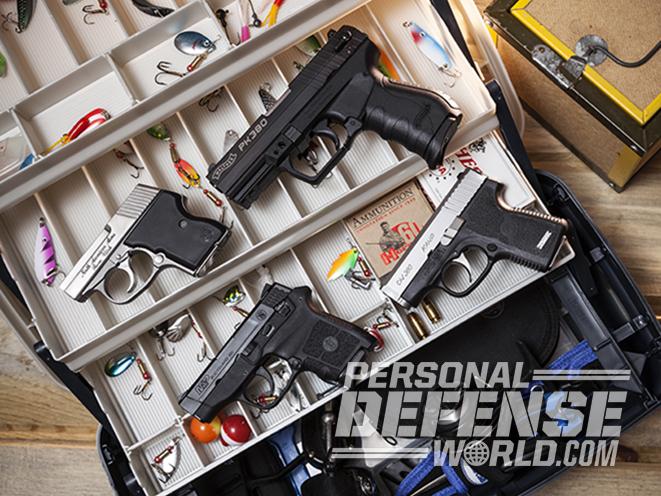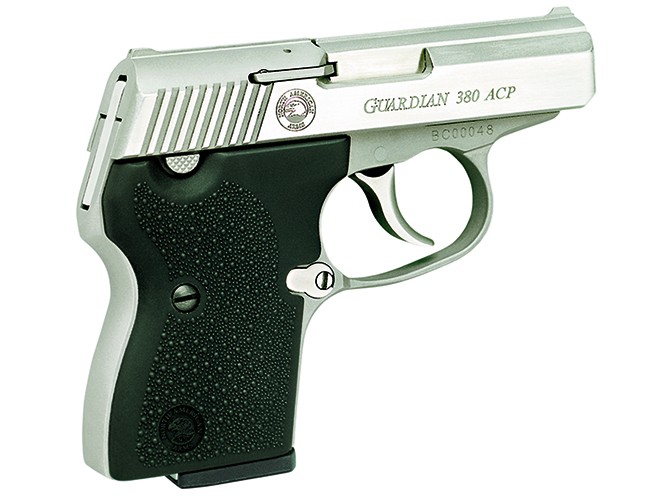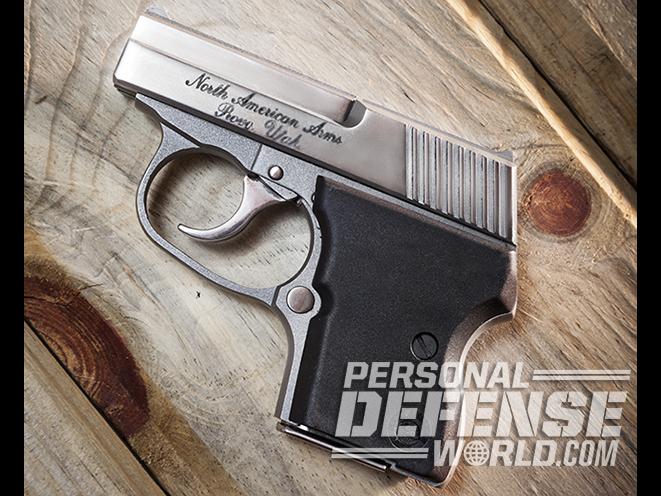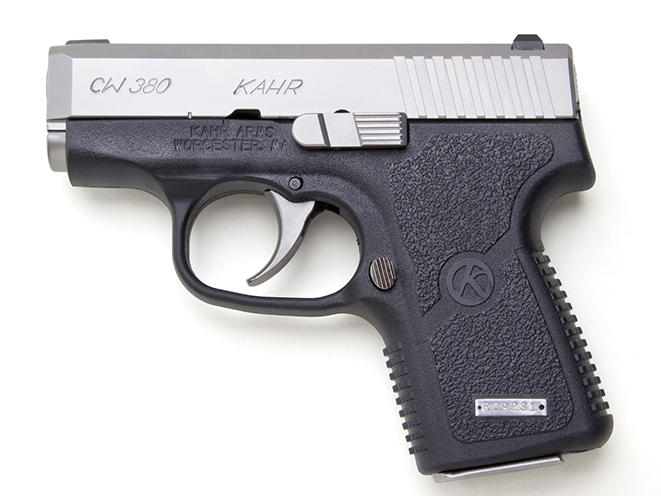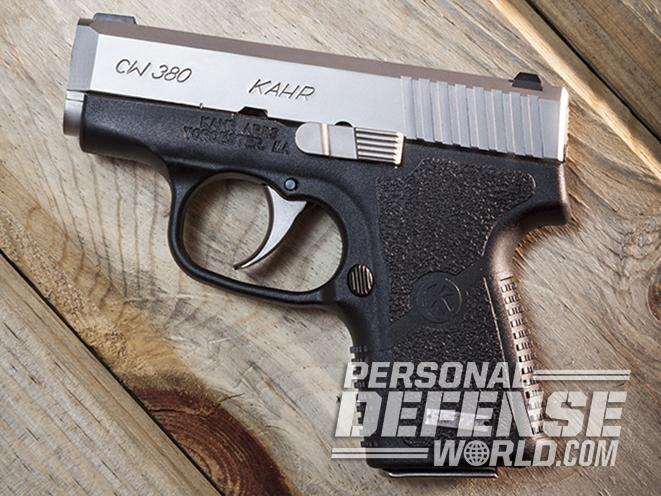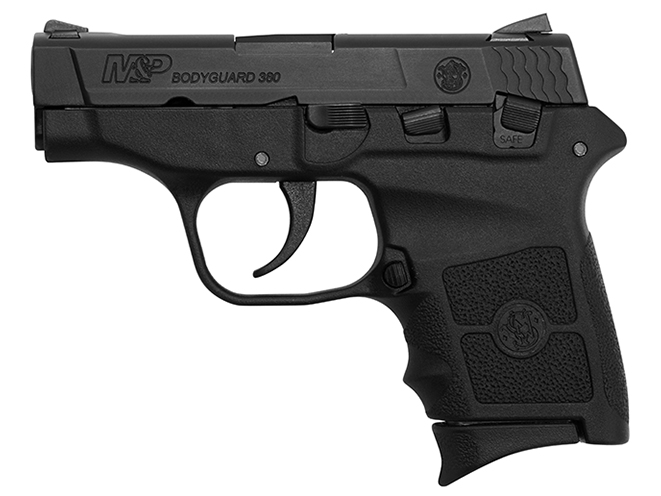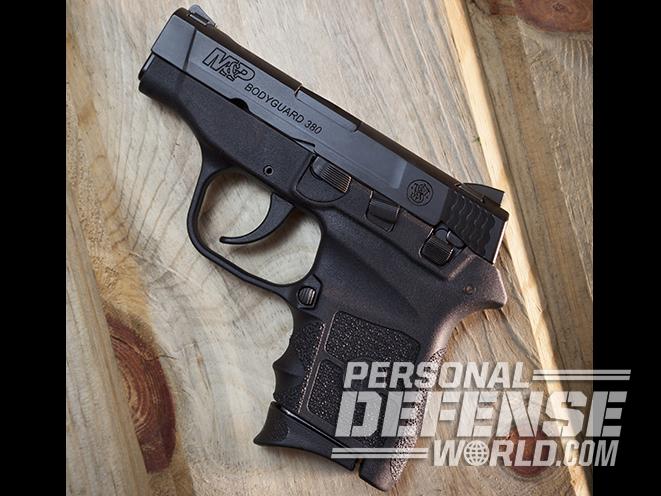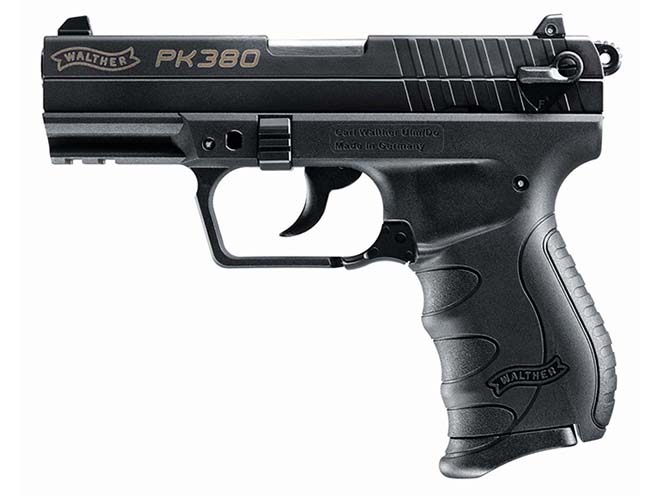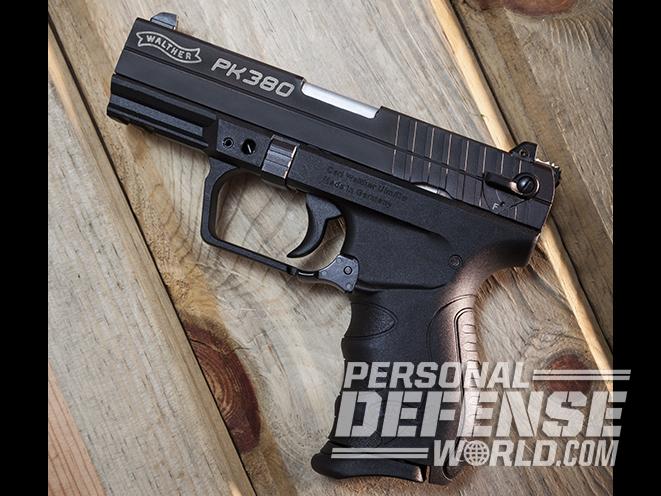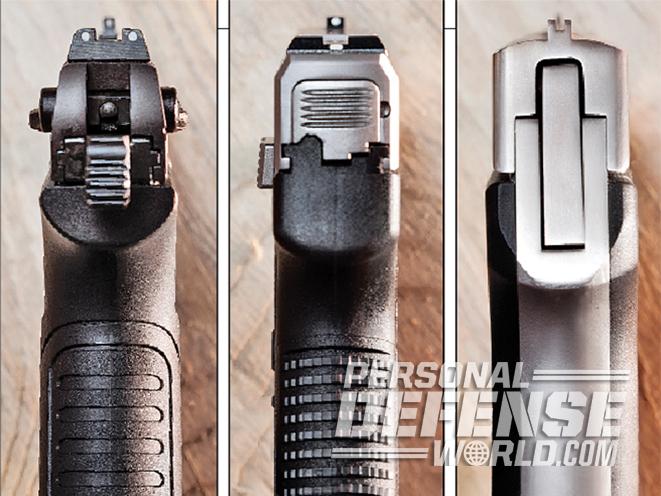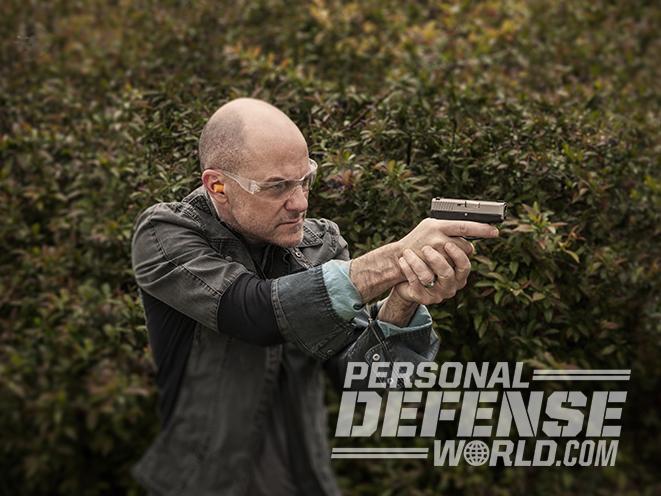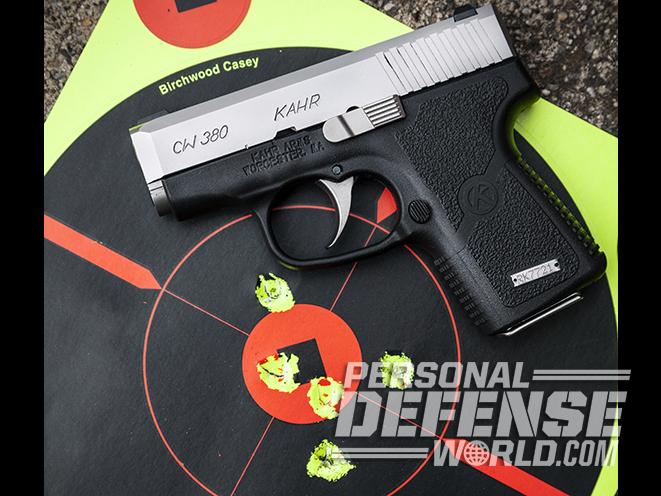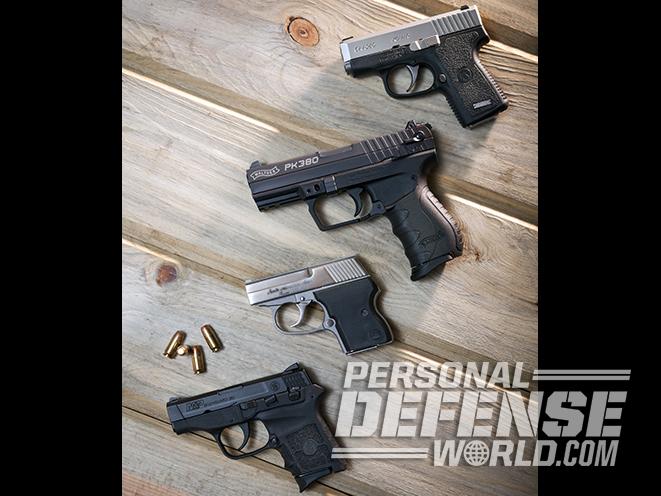In the May 2016 issue of “Combat Handguns,” I wrote about Tackle Box .22s, along with their likely uses and drawbacks. While .22s are great for plinking and taking small game, the primary limitation of rimfire handguns is simply their lack of oomph. If you want a compact, tackle-box-sized pistol with greater power for dispatching rabid skunks, foxes or coyotes—or protecting yourself from two-legged predators—you need to step up your game to 380 pistols.
The .380 (9mm Kurz) cartridge has long been a staple of European police forces, and it’s becoming increasingly popular in the United States. When it comes to practical, useable power, it’s head and shoulders above .22 rimfires. The .380 is probably the minimum you should consider for serious self-defense. Several .380 pistols fit handily into a tackle box or the pocket of your fishing vest. You’ll hardly know the gun is there until you need to use it.
While 380 pistols generate greater recoil than .22s, they’re not all that hard to handle and shoot well. It just requires practice to become proficient. Though ear protection is a must if you don’t want to lose a tiny—but irretrievable—bit of hearing every time you trigger a round. The .380 is truly “the mouse that roared!”
Advertisement — Continue Reading Below
The Sentinel
The North American Arms Guardian is the smallest—yet heaviest—of the 380 pistols I’ve used. While just 4.81 inches long, it tips the scales at a relatively heavy 20.4 ounces thanks to its all-stainless steel construction. That said, the corrosion resistance is a big plus for backcountry carry.
The double-action-only (DAO) Guardian has an extremely long, hard trigger pull. Because it’s so heavy, I couldn’t measure the trigger pull weight with my RCBS scale. Another negative is the vestigial sights, which don’t lend themselves to fast target acquisitions. The sights are non-adjustable; they work up close but aren’t great for anything beyond 20 yards.
- RELATED STORY: 4 Compact, Lightweight Rimfire Revolvers For Your Tackle Box
The first time I fired this gun, I had nine malfunctions in the first 100 rounds. These included failures to feed and “stove-pipes” with a variety of different loads. The next 100 rounds were less problematic, with just five failures. I gave the gun and my sore trigger finger a rest and returned home. I went back to the range two days later, after cleaning the Guardian. That’s when the little gun settled down and chewed through the next 100 rounds with only a lone feeding failure.
Advertisement — Continue Reading Below
This little gun probably needs to fire 300 rounds to properly break-in and perform reliably. This isn’t unusual in small pocket guns or even full-sized autoloaders. I wouldn’t trust any autopistol until it goes through a similar firing test.
On the plus side, its diminutive size offers some real advantages, whether you’re finding room in your tackle box or carrying the gun in your pocket or belt holster. I’ve owned a couple of Guardians over the years, and once ‘broken in,” they’ve all proven comfortingly reliable with the ammunition they like.
Kahr Insurance
Just 4.96 inches long, Kahr’s CW380 is eminently suitable for packing in your tackle box or tucking away in your pocket. You’ll barely notice its scant 10.2-ounce heft thanks to the little gun’s polymer grip frame. The slide and barrel are made of stainless steel, a combination that is both lightweight and corrosion resistant.
Advertisement — Continue Reading Below
Like the Guardian, the CW380 has a DAO trigger, and it breaks at just under 5.5 pounds of pressure. There’s no manual safety, either—this is an uncomplicated “point and pull” affair. An internal block prevents the striker from moving forward unless the trigger is depressed.
Kahr recommends a 200-round break-in before you depend on its reliability. My sample produced only three feeding failures with a variety of ammo during the break-in period. Malfunctions are now few and far between. I’ve had the best luck with round-nose ammo. If I planned on buying this gun, I’d find the ammo it liked best and stick with that choice. I’ve learned that .380 pistols can be fussy about what they’re fed.
This little gun fits nicely in my hand, and the recoil is easily controlled. The sights are well designed with an eye-catching white dot up front and a rear sight that’s drift-adjustable for windage. The rear sight also sports a single white dot that aids in fast targeting. Fired offhand from 15 yards, it proved capable of printing 2.5-inch five-shot groups.
Advertisement — Continue Reading Below
Personal Protector
Smith & Wesson’s M&P Bodyguard 380 is 5.3 inches long and weighs a light 12-ounces. It has a polymer grip and a matte black stainless steel slide and barrel. The slide is coated in an Armonite finish. That com-bination makes this little gun corrosion resistant when tucked into a tackle box.
This DAO handgun is hammer-fired with a trigger that breaks under 9 pounds of pressure. The trigger is so smooth that it feels lighter than it actually is. Also, while not a major point, the gun offers a “second-strike” capability. If the chambered round fails to fire, pulling the trigger a
second time may result in a discharge.
The slide is easier to rack than the other guns tested. This is a big plus for me and many other older shooters that have deteriorating hand strength. Believe me, that’s a serious consideration when it comes to selecting an autopistol.
Advertisement — Continue Reading Below
The M&P Bodyguard 380 also fits my hand very well. The grip has finger grooves, and my little finger curls naturally under the magazine. While it still fits into my tackle box, it’s notably larger than the other .380s reviewed here. That makes it easier to control and shoot well. And despite its size, it produces less recoil than the smaller guns.
The sights are easy to see, and both the front and rear are drift-adjustable for windage changes. The three-white-dot aiming system allows for fast aiming. With the help of a small Allen wrench, the rear sight can be anchored in place after changes in windage.
Dressed In Black
The Walther PK380 is a locked-breech design, and its grip should accommodates all of your strong-hand fingers. This hammer-fired pistol fits in my hand very nicely, allowing good control.
Advertisement — Continue Reading Below
The gun has a short dust-cover rail for installing laser sights, flashlights or other aiming aids. I’m not a fan of aftermarket laser sights for compact .380 ACP pistols, but it’s nice to have this option.
The Walther PK380 also has no slide release. You have to manually retract the slide, then release it to chamber the first round from the magazine. According to other shooters, the slide is supposed to be easy to rack. However, the slide on my test gun would sometimes lock up, and I had to use a Handi-Racker to solve the problem. Thanks to a developing myopathy, I have weak hands, which didn’t help.
- RELATED STORY: Tests & Scores of the 4 Most Popular Polymer 45 ACP Pistols
When firing in DA mode, the trigger pull is long and weighs around 9 pounds. After firing the first shot, the gun goes into single-action (SA) mode with a crisp 5-pound pull. As for the other controls, an ambidextrous paddle-style safety is located at the base of the triggerguard. This is a unique arrangement that takes some getting used to, but the safety is easy to reach and works very well. It was very stiff when the gun was brand new, but this issue went away with use.
Advertisement — Continue Reading Below
The biggest problem I have with this gun is that you must use a special tool to take it down for cleaning or maintenance. Quite frankly, this is a pain. If you misplace this strange-looking tool, you’ll have to go to a gun store or write the company to replace it. This is a “feature” Walther would do well to reconsider.
Also, when my test sample sometimes locked up, it required some fiddling to release the slide and trigger. I’ll be sending this particular gun back to let Walther solve this issue, but otherwise it ran well.
Feed ‘Em Right
Because each of these 380 pistols prefers different kinds of ammo, I fired a lot of rounds to see what loads worked best. The ammo used included Winchester 95-grain FMJ fodder that worked well in all four guns. The FMJ bullets fed smoothly (after the break-in period) and delivered good accuracy. Hornady Critical Defense loads featuring tapered FTX hollow points also earned high points in regards to reliability. CorBon ammo loaded with 90-grain JHPs produced velocities in the 990-fps range and fed well in spite of their hollow-point bullets.
Advertisement — Continue Reading Below
Each gun will have its own preferences, so it’s best to try a variety of loads to see which it prefers. Most of the loads I tested delivered good accuracy and decent reliability. Fired off-hand at 15 yards, five-shot groups measuring 2.5 inches between centers were possible with the ammo each gun seemed to like best. The largest groups ran around 4 inches. One notable exception proved to be Wolf ammunition, which proved uniformly balkier than most.
380 Pistols Specs
| Manufacturer | Kahr CW380 | North American Arms Guardian | S&W M&P Bodyguard 380 | Walther PK380 |
|---|---|---|---|---|
| Caliber | .380 ACP | .380 ACP | .380 ACP | .380 ACP |
| Barrel | 2.58 inches | 2.5 inches | 2.75 inches | 3.66 inches |
| OA Length | 4.96 inches | 4.81 inches | 5.3 inches | 6.5 inches |
| Weight | 10.2 ounces (empty) | 20.4 ounces (empty) | 12 ounces (empty) | 18 ounces (empty) |
| Grip | Polymer | Hard Rubber | Polymer | Polymer |
| Sights | White bar-dot | Fixed | Adjustable | Three-dot, adjustable rear |
| Action | Striker-fired | DAO | DAO | DA/SA |
| Finish | Matte black, stainless | Stainless | Matte black | Matte black |
| Capacity | 6+1 | 6+1 | 6+1 | 8+1 |
| MSRP | $419 | $456 | $379 | $359 |
For More Information
Kahr CW380
kahr.com
North American Arms Guardian
northamericanarms.com
Smith & Wesson M&P Bodyguard 380
smith-wesson.com
Walther PK380
waltherarms.com
This article was originally published in “Pocket Pistols” 2018. To order a copy, go to outdoorgroupstore.com.
